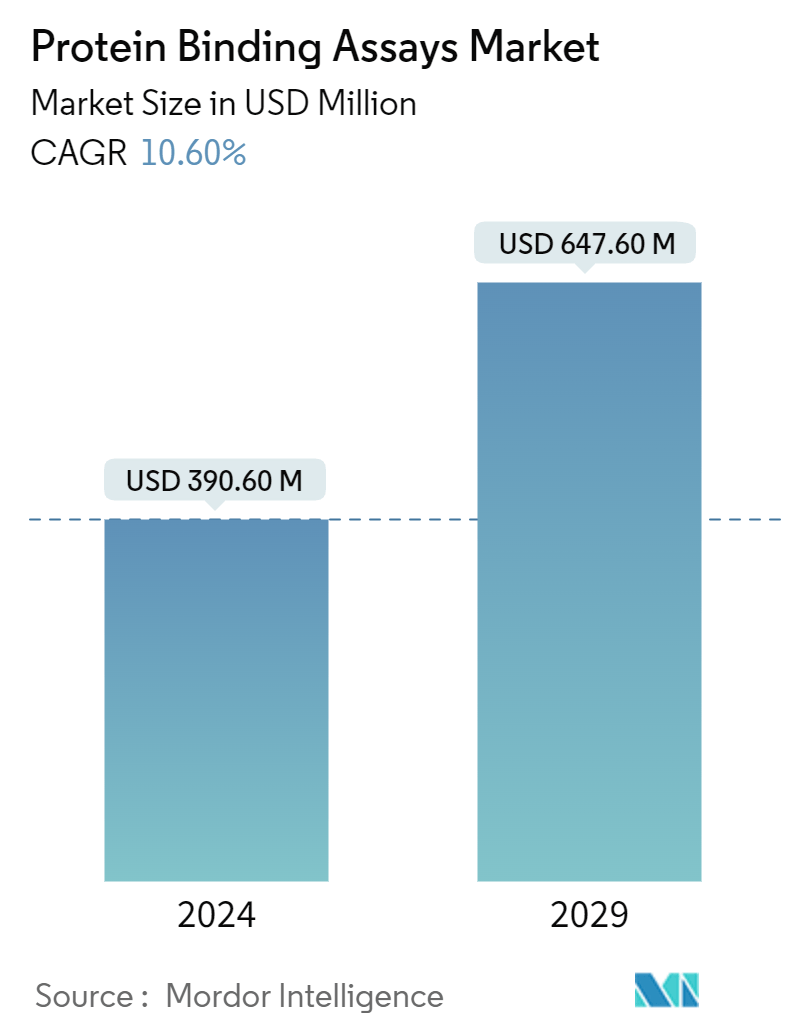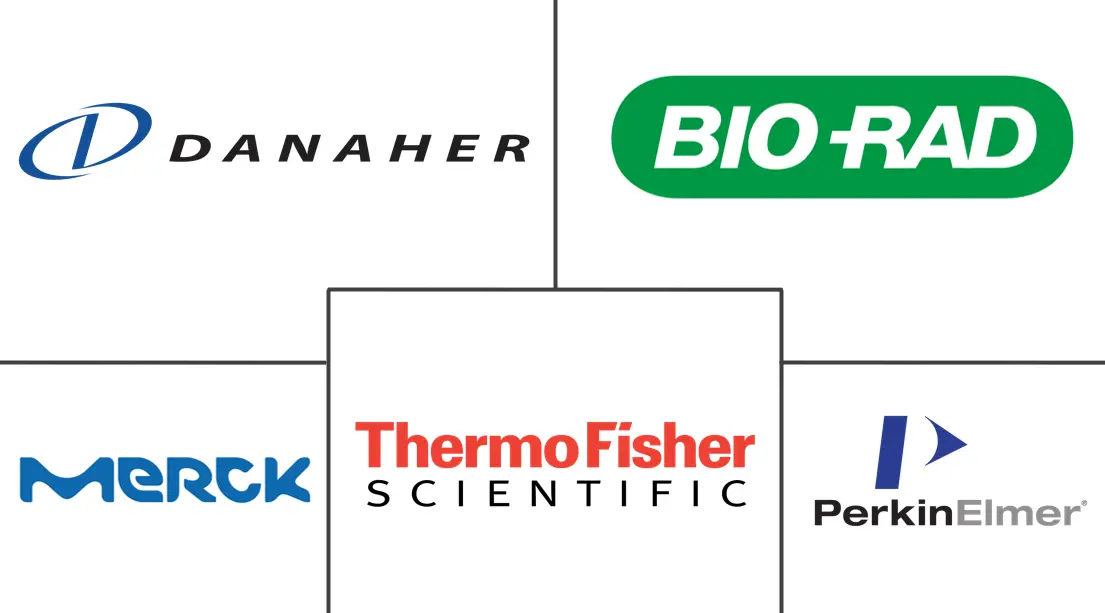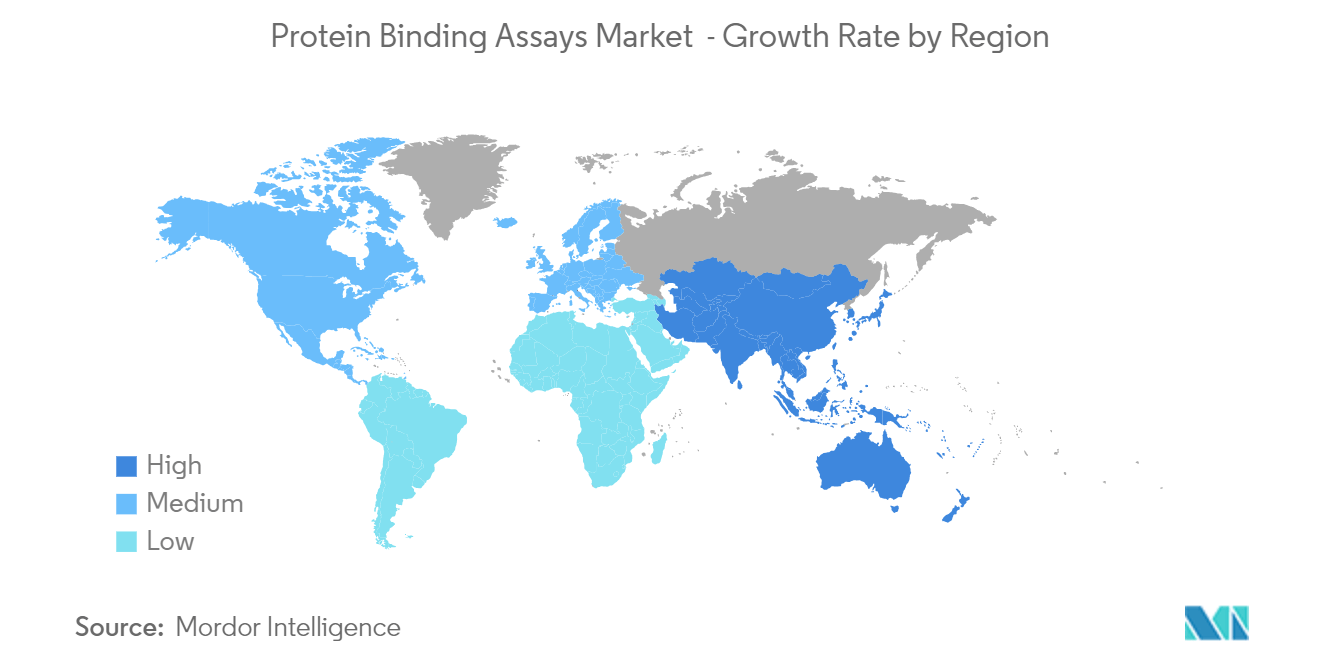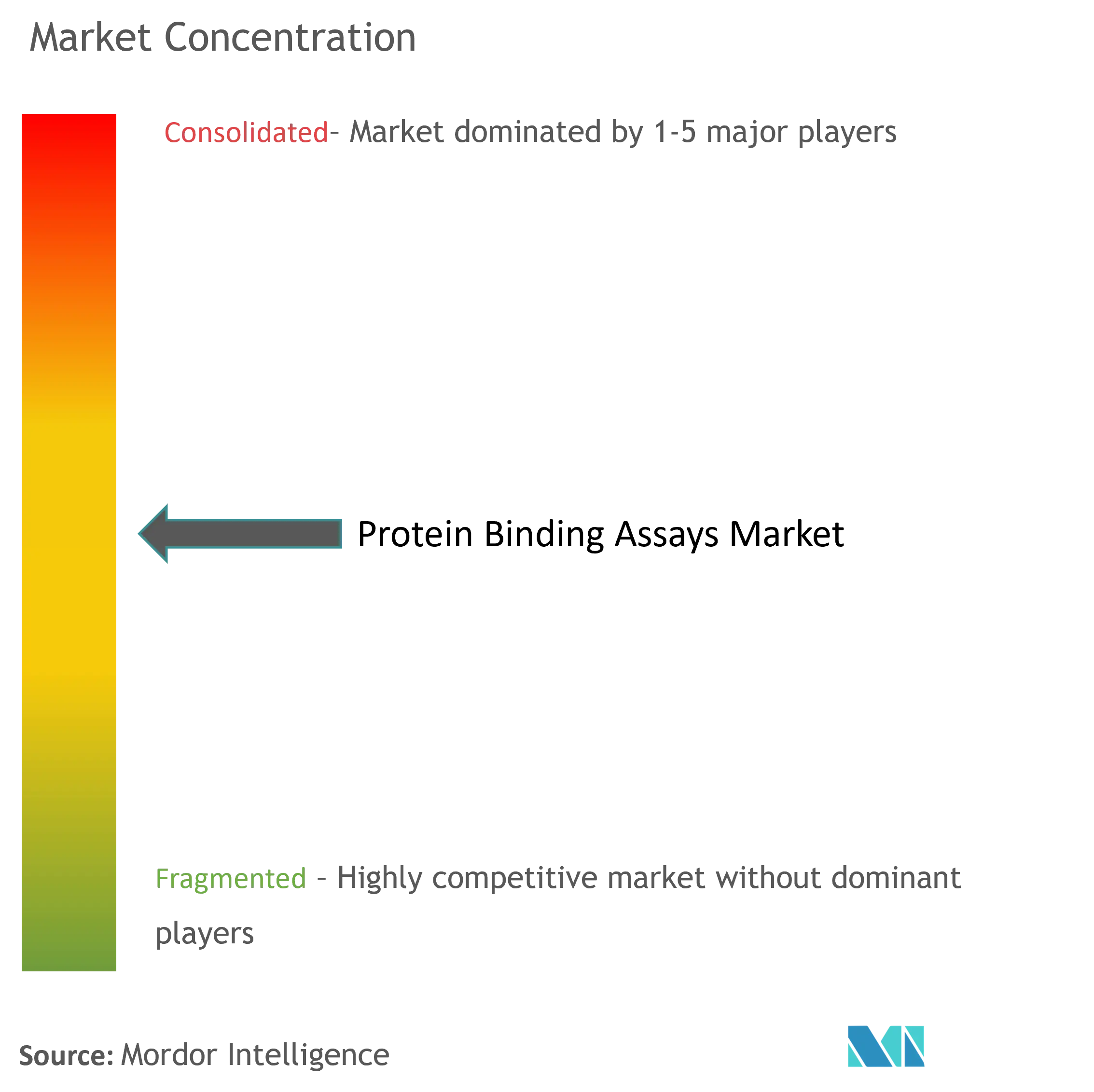Protein Binding Assay Market Size

| Study Period | 2019 - 2029 |
| Market Size (2024) | USD 390.60 Million |
| Market Size (2029) | USD 647.60 Million |
| CAGR (2024 - 2029) | 10.60 % |
| Fastest Growing Market | Asia Pacific |
| Largest Market | North America |
Major Players
*Disclaimer: Major Players sorted in no particular order |
Protein Binding Assay Market Analysis
The Protein Binding Assays Market size is estimated at USD 390.60 million in 2024, and is expected to reach USD 647.60 million by 2029, growing at a CAGR of 10.60% during the forecast period (2024-2029).
The protein binding assay market is influenced by several factors that impact its growth and adoption in life sciences. Some of the major driving factors include rising demand for personalized medicine, increasing drug development activities, and technological advancements in assay technologies.
The growing pharmaceutical industry and continuous efforts in drug discovery drive the demand for protein-binding assays. These assays are essential for evaluating drug-protein interactions, optimizing drug candidates, and improving therapeutic efficacy. Drug development is rising year-over-year, with many medicines undergoing clinical evaluation and achieving quicker approval timelines. For instance, according to the data published by the Government of Canada in August 2023, the global pipeline boasted over 9,000 new medicines in diverse stages of clinical development in 2022, a notable increase from the previous year's count of under 8,500. This shows the growing number of drug developments, which is expected to increase the need for protein-binding assays, thereby boosting the market growth during the forecast period.
Also, advancements in assay technologies, such as high-throughput screening, fluorescence-based assays, and automated systems, enhance protein binding assays' efficiency, sensitivity, and accuracy. This attracts pharmaceutical companies and research institutions to adopt these technologies, which is expected to propel the market growth during the forecast period. In addition, in January 2023, Thermo Fisher Scientific Inc. completed its acquisition of The Binding Site Group, a prominent global player in specialty diagnostics. The Binding Site specializes in diagnostic assays, focusing on protein binding, and offers cutting-edge instruments. Hence, these company's strategic activities, such as acquisitions and collaborations, will likely increase market growth during the forecast period.
However, the high cost of assay development and implementation and the complexity of assay standardization are expected to restrain the market growth during the forecast period.
Protein Binding Assay Market Trends
The Drug Discovery Segment is Expected to Have a Significant Share in the Market During the Forecast Period
The drug discovery application segment in the protein binding assay market is witnessing robust growth and is poised to maintain this momentum during the forecast period. This growth is fueled by several factors, including increasing R&D expenditure, demand for high-throughput screening, and the growing biopharmaceutical industry.
Pharmaceutical and biotechnology companies invest heavily in research and development, particularly drug discovery. Protein binding assays play a crucial role in this process by enabling researchers to assess how drugs interact with target proteins. This is essential for identifying lead compounds, optimizing drug candidates, and boosting segment growth.
For instance, according to the data published by the International Federation of Pharmaceutical Manufacturers and Associations report published in January 2023, pharmaceutical research and development spending is estimated to be USD 213 billion by 2026 from USD 189 billion in 2022. This growing R&D spending is expected to increase drug developments and the need for protein-binding assays, which will likely propel market growth during the forecast period.
Also, establishing new development facilities is expected to increase the need for protein-binding assay products. For instance, in June 2024, Aurigene Pharmaceutical Services Limited unveiled its new 70,000 sq. ft. biologics facility in Genome Valley, Hyderabad, India. The facility is situated within this biocluster and is designed to meet clients' needs, providing process and analytical development services. It specializes in small-scale manufacturing of antibodies and other recombinant proteins, primarily targeting preclinical and early-phase clinical demands. These new facilities will raise the market for more protein-binding assay products, boosting segment growth during the forecast period.
Therefore, with growing R&D investments and spending and the establishment of new drug development facilities, the drug discovery segment is expected to grow significantly in the market during the forecast period.

North America is Expected to Have Significant Growth in the Market During the Forecast Period
North America has been experiencing significant growth in the market owing to factors such as robust healthcare infrastructure, substantial investments in research and development, and a supporting regulatory environment. In addition, the market of protein binding assays in North America is expected to continue expanding as new technologies emerge and the need for accurate drug development and testing intensifies.
The growing funding for research and development in biotechnology is expected to develop new products in the region. For instance, according to data published by the National Institutes of Health (NIH) in May 2024, the research funding for the biotechnology industry was reported to be USD 8,851 million in 2023, which is estimated to be USD 9,344 million by 2025 in the United States. This shows the growing research funding for biotechnology, which is expected to increase the development of new protein-binding assay products, thereby boosting the market growth during the forecast period in the region.
In addition, in October 2023, the Government of Canada declared its commitment to revitalizing the domestic biomanufacturing industry. Its goal is to enhance the production of safe and effective treatments for the nation's citizens. Hence, protein binding assays are necessary for safe and effective products, which is expected to increase the demand for protein binding assay products and boost the market growth in the region.
Also, the company's strategic activities in offering proteomics in which protein binding assays are widely used are expected to boost the market growth in the region. For instance, in November 2023, Momentum Biotechnologies rolled out a suite of new services, honing in on proteomics. Their expanded offerings encompass targeted and global proteomics, chemoproteomics, and comparative proteomics, all leveraging TMT-labelling protocols. Momentum has channeled substantial investments into hardware and automation.
Therefore, owing to the factors mentioned above, such as research funding and new proteomics service offerings, the growth of the market is anticipated in North America.

Protein Binding Assay Industry Overview
The protein binding assay market is semi-consolidated due to the presence of only major players operating globally and regionally. The analysis delves into international companies dominating substantial market shares, shaping the competitive landscape. Some of the major players in the market include Thermo Fisher Scientific Inc., Merck KGaA, Bio-Rad Laboratories, PerkinElmer Inc., Danaher Corporation (Cytiva), and Abcam.
Protein Binding Assay Market Leaders
-
Thermo Fisher Scientific, Inc.
-
Merck KGaA
-
Bio-Rad Laboratories
-
Danaher Corporation (Cytiva)
-
PerkinElmer, Inc.
*Disclaimer: Major Players sorted in no particular order

Protein Binding Assay Market News
- May 2024: Standard BioTools Inc. acquired Carterra's LSAXT system, a key solution for high-throughput screening and characterization of large and small molecules. With this acquisition, Standard BioTools aims to enhance the validation of its SomaScan Platform. The LSAXT system will play a pivotal role in measuring the kinetic properties of SOMAmer Reagents, providing customers with accurate insights into protein binding and biomarker characterization.
- February 2024: Sysmex Corporation planned to launch the HISCL M2BPGi-Qt Assay Kit in Japan. The kit is designed to measure the Mac-2 binding protein (M2BP) glycosylation isomer in serum or plasma, aiding in the diagnosis of hepatic fibrosis progression.
Protein Binding Assays Market Report - Table of Contents
1. INTRODUCTION
- 1.1 Study Assumptions and Market Definition
- 1.2 Scope of the Study
2. RESEARCH METHODOLOGY
3. EXECUTIVE SUMMARY
4. MARKET DYNAMICS
- 4.1 Market Overview
-
4.2 Market Drivers
- 4.2.1 Increasing Drug Development Activities
- 4.2.2 Rising Demand for Personalized Medicine and Advancements in Assay Technologies
-
4.3 Market Restraints
- 4.3.1 High Cost of Assay Development and Complexity in Assay Standardization
-
4.4 Porter's Five Force Analysis
- 4.4.1 Threat of New Entrants
- 4.4.2 Bargaining Power of Buyers/Consumers
- 4.4.3 Bargaining Power of Suppliers
- 4.4.4 Threat of Substitute Products
- 4.4.5 Intensity of Competitive Rivalry
5. MARKET SEGMENTATION (Market Size by Value - USD)
-
5.1 By Product Type
- 5.1.1 Assay Kits and Reagents
- 5.1.2 Instruments
-
5.2 By Technology
- 5.2.1 Fluorescence-based Assays
- 5.2.2 Equilibrium Dialysis
- 5.2.3 Ultrafiltration
- 5.2.4 Other Technologies
-
5.3 By Application
- 5.3.1 Drug Discovery
- 5.3.2 Clinical Diagnostics
- 5.3.3 Proteomics Research
- 5.3.4 Other Applications
-
5.4 By End User
- 5.4.1 Academic and Research Institutes
- 5.4.2 Pharmaceutical and Biotechnology Companies
- 5.4.3 Contract Research Organizations (CROs)
- 5.4.4 Other End Users
-
5.5 Geography
- 5.5.1 North America
- 5.5.1.1 United States
- 5.5.1.2 Canada
- 5.5.1.3 Mexico
- 5.5.2 Europe
- 5.5.2.1 Germany
- 5.5.2.2 United Kingdom
- 5.5.2.3 France
- 5.5.2.4 Italy
- 5.5.2.5 Spain
- 5.5.2.6 Rest of Europe
- 5.5.3 Asia-Pacific
- 5.5.3.1 China
- 5.5.3.2 Japan
- 5.5.3.3 India
- 5.5.3.4 Australia
- 5.5.3.5 South Korea
- 5.5.3.6 Rest of Asia-Pacific
- 5.5.4 Rest of the World
6. COMPETITIVE LANDSCAPE
-
6.1 Company Profiles
- 6.1.1 Thermo Fisher Scientific Inc.
- 6.1.2 Merck KGaA
- 6.1.3 PerkinElmer Inc.
- 6.1.4 Bio-Rad Laboratories Inc.
- 6.1.5 Danaher Corporation (Cytiva)
- 6.1.6 Abcam Limited
- 6.1.7 Promega Corporation
- 6.1.8 Enzo Biochem Inc.
- 6.1.9 BioLegend Inc.
- 6.1.10 Cell Signaling Technology Inc.
- *List Not Exhaustive
7. MARKET OPPORTUNITIES AND FUTURE TRENDS
** Subject To AvailablityProtein Binding Assay Industry Segmentation
As per the scope of the report, protein binding assays refer to a set of laboratory techniques designed to measure the interaction between proteins and other molecules, such as drugs, ligands, small molecules, nucleic acids, or other proteins. These assays assess how strongly and specifically a molecule binds to a protein of interest.
The protein binding assays market is segmented by product type, technology, application, end users, and geography. By product type, the market is segmented into assay kits and reagents and instruments. By technology, the market is segmented into fluorescence-based assays, equilibrium dialysis, ultrafiltration, and other technologies. By application, the market is segmented into drug discovery, clinical diagnostics, proteomics research, and other applications. By end user, the market is segmented into academic and research institutes, pharmaceutical and biotechnology companies, contract research organizations, and other end users. By geography, the market is segmented into North America, Europe, Asia-Pacific, and the Rest of the world. The report offers the value (in USD) for the above segments.
| By Product Type | Assay Kits and Reagents | |
| Instruments | ||
| By Technology | Fluorescence-based Assays | |
| Equilibrium Dialysis | ||
| Ultrafiltration | ||
| Other Technologies | ||
| By Application | Drug Discovery | |
| Clinical Diagnostics | ||
| Proteomics Research | ||
| Other Applications | ||
| By End User | Academic and Research Institutes | |
| Pharmaceutical and Biotechnology Companies | ||
| Contract Research Organizations (CROs) | ||
| Other End Users | ||
| Geography | North America | United States |
| Canada | ||
| Mexico | ||
| Geography | Europe | Germany |
| United Kingdom | ||
| France | ||
| Italy | ||
| Spain | ||
| Rest of Europe | ||
| Geography | Asia-Pacific | China |
| Japan | ||
| India | ||
| Australia | ||
| South Korea | ||
| Rest of Asia-Pacific | ||
| Geography | Rest of the World |
Protein Binding Assays Market Research FAQs
How big is the Protein Binding Assays Market?
The Protein Binding Assays Market size is expected to reach USD 390.60 million in 2024 and grow at a CAGR of 10.60% to reach USD 647.60 million by 2029.
What is the current Protein Binding Assays Market size?
In 2024, the Protein Binding Assays Market size is expected to reach USD 390.60 million.
Who are the key players in Protein Binding Assays Market?
Thermo Fisher Scientific, Inc., Merck KGaA, Bio-Rad Laboratories, Danaher Corporation (Cytiva) and PerkinElmer, Inc. are the major companies operating in the Protein Binding Assays Market.
Which is the fastest growing region in Protein Binding Assays Market?
Asia Pacific is estimated to grow at the highest CAGR over the forecast period (2024-2029).
Which region has the biggest share in Protein Binding Assays Market?
In 2024, the North America accounts for the largest market share in Protein Binding Assays Market.
What years does this Protein Binding Assays Market cover, and what was the market size in 2023?
In 2023, the Protein Binding Assays Market size was estimated at USD 349.20 million. The report covers the Protein Binding Assays Market historical market size for years: 2019, 2020, 2021, 2022 and 2023. The report also forecasts the Protein Binding Assays Market size for years: 2024, 2025, 2026, 2027, 2028 and 2029.
Protein Binding Assays Industry Report
Statistics for the 2024 Protein Binding Assays market share, size and revenue growth rate, created by Mordor Intelligence™ Industry Reports. Protein Binding Assays analysis includes a market forecast outlook for 2024 to 2029 and historical overview. Get a sample of this industry analysis as a free report PDF download.



